steering wheel MERCEDES-BENZ B-CLASS HATCHBACK 2008 Owners Manual
[x] Cancel search | Manufacturer: MERCEDES-BENZ, Model Year: 2008, Model line: B-CLASS HATCHBACK, Model: MERCEDES-BENZ B-CLASS HATCHBACK 2008Pages: 305, PDF Size: 5.1 MB
Page 12 of 305

9
Malfunction memory
see Message memory menu
Manual transmission........................... 91
Maximum speed Technical data. ............................... 280
Memory card ...................................... 103
Operation (on-board computer). .....103
see separate operating instructions
Menu (on-board computer)................ 100
Audio. ............................................. 102
DVD. ............................................... 104
Message memory. .......................... 105
Navigation. ..................................... 104
Operating........................................ 101
Resetting to factory settings........... 105
Settings .......................................... 105
Submenu overview. ........................106
Telephone. ...................................... 112
Trip computer. ................................ 111
Messages
see Display messages
see Message memory menu
see Warning and indicator lamps
Minispare emergency spare wheel
Technical data. ............................... 285
Mirrors
Sun visor......................................... 161
Mobile phone...................................... 163
Display message..................... 210, 221 Installation.
..................................... 275
Telephone menu (on-board com-
puter). ............................................. 112
Modifying the programming
Key. .................................................. 60
MOExtended run-flat system* ..178, 262
MP3..................................................... 103
Operating (on-board computer)
....................................................... 103
see separate operating instructions
Multi-contour backrest........................ 68
Multi-function display ....................97, 99
Multi-function steering wheel............. 98
Overview. .......................................... 30 N
Navigation........................................... 104 Navigation menu (on-board com-
puter). ............................................. 104
see separate operating instructions O
Odometer Total distance recorder. ....................26
Trip meter. ........................................ 26
Oil
Consumption. ................................. 172
Topping up. ..................................... 174Oil level
Checking (dipstick). ........................174
Checking (on-board computer). ......173
On-board computer.............................. 98
Audio menu. ................................... 102
Convenience submenu. ..................107
Display messages ........................... 202
DVD menu ...................................... 104
Factory settings .............................. 105
Instrument cluster submenu ...........106
Lighting submenu. ..........................107
Message memory menu.................. 105
Navigation menu. ............................ 104
Operation menu. ............................. 101
Settings menu ................................ 105
Standard display menu. ..................102
Telephone menu. ............................ 112
Time/date submenu. ......................106
Trip computer menu. ......................111
Vehicle submenu. ........................... 107
On-board computer language ...........107
One-touch gearshifting........................ 93
Operating system see On-board computer
Outside temperature display .............98
On-board computer. .......................102
Override feature
Rear side windows ............................ 54 Index
245_AKB; 2; 7, en-GB
wdomann,
Version: 2.11.4
2008-10-17T11:22:31+02:00 - Seite 9 Dateiname: 6515_1640_02_buchblock.pdf; preflight
Page 14 of 305

11S
Seat Adjusting. ................................... 63, 65
Correct driver's seat position. ..........75
Folding the rear bench seat
forward. .......................................... 149
Removing/fitting the front-
passenger seat. .............................. 155
Removing/fitting the rear seat
backrest. ........................................ 151
Removing/fitting the rear seat
cushion. .......................................... 150
Seat belt
Adjusting the height.......................... 74
Display message .......................74, 212
Fastening. ......................................... 72
Warning lamp. .......................... 74, 228
Seat cushion
Removing (rear bench seat). ...........150
Seat heating......................................... .68
Seat ventilation Malfunction indicator lamp. ............222
Securing a load................................... 146
Selector lever Positions. .......................................... 93
Service indicator................................ 191
Service products................................ 291
Brake fluid. ..................................... 299Coolant.
.......................................... 297
Windscreen washer fluid. ................299
Settings
Factory (on-board computer). .........105
Setting the unit (on-board computer)
Speedometer. ................................. 107
Sidebags................................................ 41
Side window
Fault. .............................................. 238
Side windows
Cleaning. ........................................ 194
Opening/closing. .............................. 83
resetting ........................................... 84
Ski rack............................................... 143
Snow chains....................................... 182
Socket Cockpit. .......................................... 162
Luggage compartment. ...................163
Rear compartment. .........................163
Spare wheel
Fitting ............................................. 258
Storage location. ............................ 200
Technical data. ............................... 285
Speed
Technical data. ............................... 280
Speed limiter
Speedtronic. ................................... 116Speedometer
Additional speedometer (on-
board computer). ............................ 102
Setting the unit (on-board com-
puter). ............................................. 107
Speedtronic........................................ 116
Display message ............................. 220
Permanent. ..................................... 119
Variabl e.......................................... 117
SRS (Supplemental Restraint Sys-
tem)....................................................... 37
Display message ............................. 211
Warning lamp. .......................... 37, 226
Standard display (on-board com-
puter) ................................................... 102
Station see Radio
Status line (on-board computer)......... 99
Selecting the display....................... 107
Steering
Display message ............................. 215
Steering assistant STEER CONTROL ...56
Steering wheel Adjusting .......................................... 69
Buttons (on-board computer)............ 98
Gearshift buttons. ............................. 95
Stowage compartment ......................158
Armrest (front) ................................ 159
Armrest (under) .............................. 160
Backrest ......................................... 161 Index
245_AKB; 2; 7, en-GB
wdomann,
Version: 2.11.4
2008-10-17T11:22:31+02:00 - Seite 11 Dateiname: 6515_1640_02_buchblock.pdf; preflight
Page 22 of 305

19
Exterior view
....................................... 20
Cockpit ................................................. 22
Instrument cluster ..............................26
Multi-function steering wheel ............30
Centre console .................................... 31
Overhead control panel ......................33
Door control panel .............................. 34 At a glance
245_AKB; 2; 7, en-GB
wdomann
, Version: 2.11.4 2008-10-17T11:22:31+02:00 - Seite 19Dateiname: 6515_1640_02_buchblock.pdf; preflight
Page 26 of 305
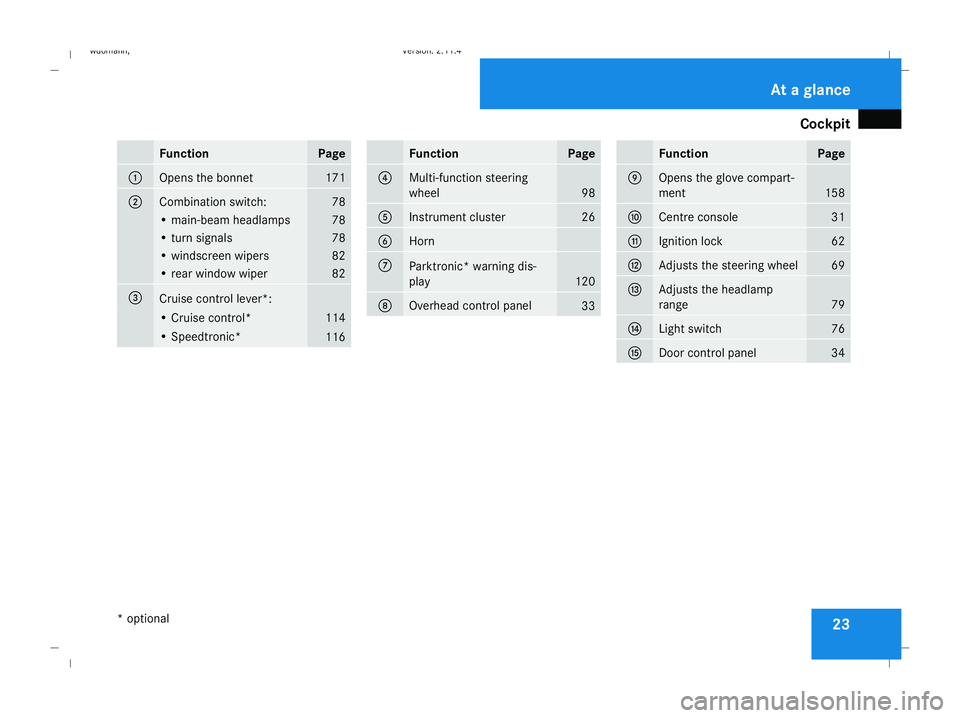
Cockpit
23Function Page
1
Opens the bonnet 171
2
Combination switch: 78
• main-beam headlamps 78
• turn signals 78
• windscreen wipers 82
• rear window wiper 82
3
Cruise control lever*:
• Cruise control* 114
• Speedtronic*
116 Function Page
4
Multi-function steering
wheel
98
5
Instrument cluster 26
6
Horn
7
Parktronic* warning dis-
play
120
8
Overhead control panel
33 Function Page
9
Opens the glove compart-
ment
158
a
Centre console 31
b
Ignition lock 62
c
Adjusts the steering wheel 69
d
Adjusts the headlamp
range
79
e
Light switch 76
f
Door control panel 34At a glance
* optional
245_AKB; 2; 7, en-GB
wdomann
,V ersion: 2.11.4
2008-10-17T11:22:31+02:00 - Seite 23 Dateiname: 6515_1640_02_buchblock.pdf; preflight
Page 28 of 305
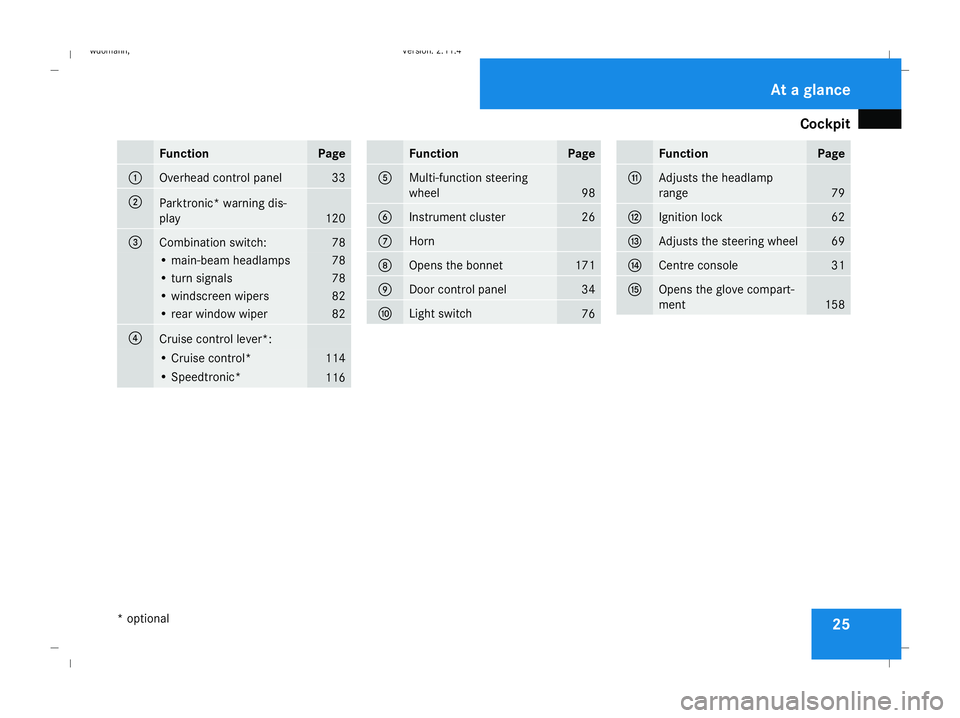
Cockpit
25Function Page
1
Overhead control panel 33
2
Parktronic* warning dis-
play
120
3
Combination switch: 78
• main-beam headlamps 78
• turn signals 78
• windscreen wipers 82
• rear window wiper 82
4
Cruise control lever*:
• Cruise control* 114
• Speedtronic*
116 Function Page
5
Multi-function steering
wheel
98
6
Instrument cluster 26
7
Horn
8
Opens the bonnet 171
9
Door control panel 34
a
Light switch
76 Function Page
b
Adjusts the headlamp
range
79
c
Ignition lock 62
d
Adjusts the steering wheel 69
e
Centre console 31
f
Opens the glove compart-
ment
158At a glance
* optional
245_AKB; 2; 7, en-GB
wdomann
,V ersion: 2.11.4
2008-10-17T11:22:31+02:00 - Seite 25 Dateiname: 6515_1640_02_buchblock.pdf; preflight
Page 33 of 305
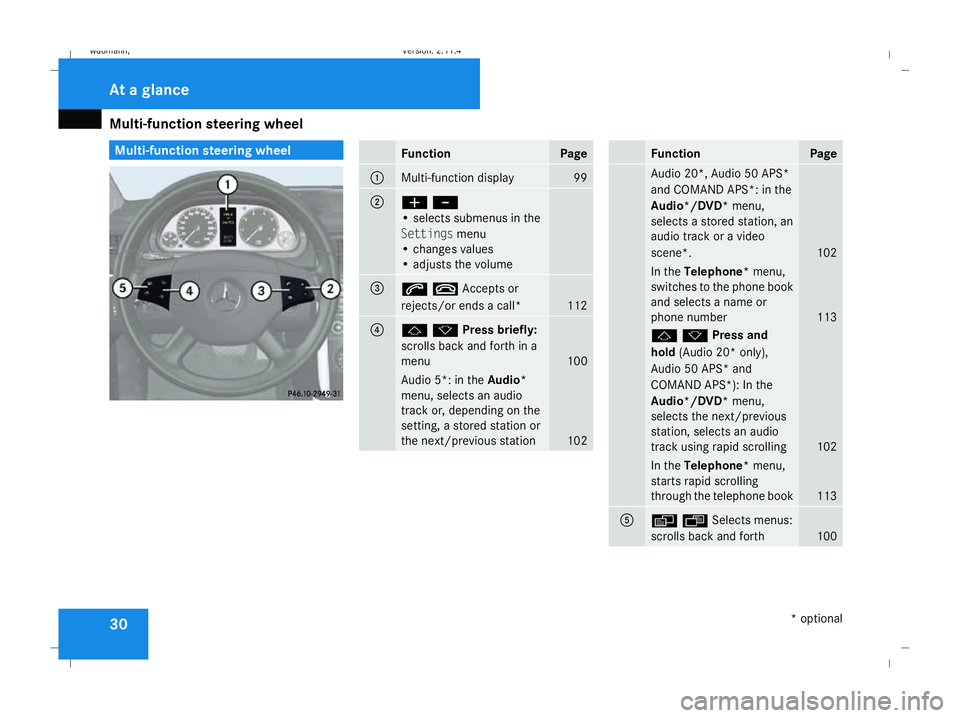
Multi-function steering wheel
30 Multi-function steering wheel
Function Page
1
Multi-function display 99
2
æ
-
• selects submenus in the
Settings menu
• changes values
• adjusts the volume 3
stAccepts or
rejects/or ends a call*
112
4
jkPress briefly:
scrolls back and forth in a
menu
100
Audio 5*: in the
Audio*
menu, selects an audio
track or, depending on the
setting, a stored station or
the next/previous station 102 Function Page
Audio 20*, Audio 50 APS*
and COMAND APS*: in the
Audio*/DVD*
menu,
selects a stored station, an
audio track or a video
scene*. 102
In the
Telephone* menu,
switches to the phone book
and selects a name or
phone number 113
jkPress and
hold
(Audio 20* only),
Audio 50 APS* and
COMAND APS*): In the
Audio*/DVD* menu,
selects the next/previous
station, selects an audio
track using rapid scrolling 102
In the
Telephone* menu,
starts rapid scrolling
through the telephone book 113
5
èÿSelects menus:
scrolls back and forth
100At a glance
* optional
245_AKB; 2; 7, en-GB
wdomann,
Version: 2.11.4 2008-10-17T11:22:31+02:00 - Seite 30Dateiname: 6515_1640_02_buchblock.pdf; preflight
Page 39 of 305
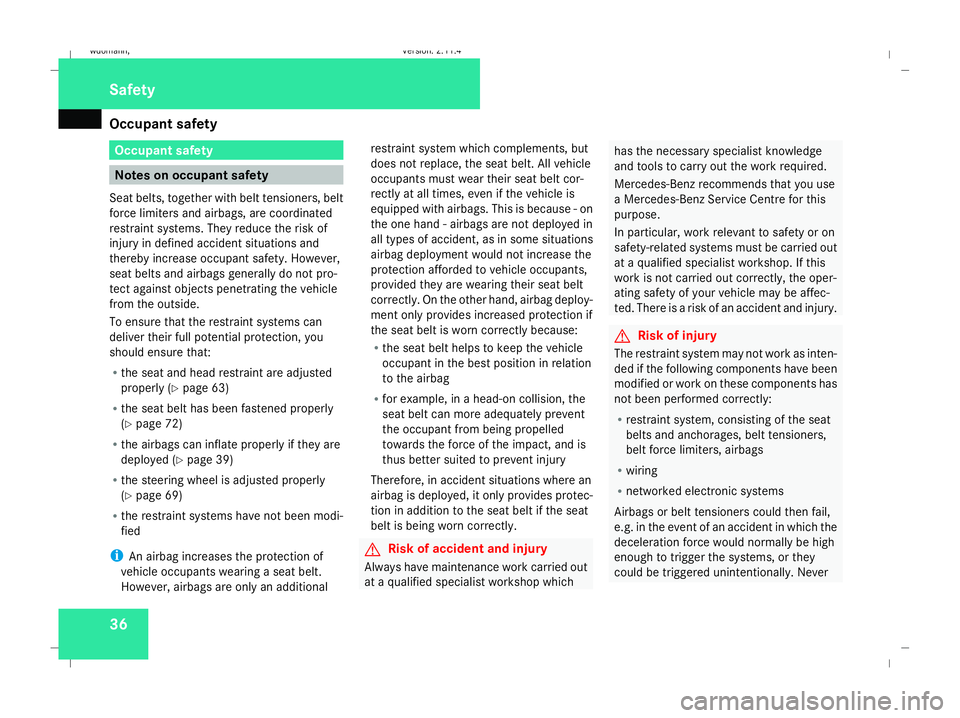
Occupant safety
36 Occupant safety
Notes on occupant safety
Seat belts, together with belt tensioners, belt
force limiters and airbags, are coordinated
restraint systems. They reduce the risk of
injury in defined accident situations and
thereby increase occupant safety. However,
seat belts and airbags generally do not pro-
tect against objects penetrating the vehicle
from the outside.
To ensure that the restraint systems can
deliver their full potential protection, you
should ensure that:
R the seat and head restraint are adjusted
properly (Y page 63)
R the seat belt has been fastened properly
(Y page 72)
R the airbags can inflate properly if they are
deployed (Y page 39)
R the steering wheel is adjusted properly
(Y page 69)
R the restraint systems have not been modi-
fied
i An airbag increases the protection of
vehicle occupants wearing a seat belt.
However, airbags are only an additional restraint system which complements, but
does not replace, the seat belt. All vehicle
occupants must wear their seat belt cor-
rectly at all times, even if the vehicle is
equipped with airbags. This is because - on
the one hand - airbags are not deployed in
all types of accident, as in some situations
airbag deployment would not increase the
protection afforded to vehicle occupants,
provided they are wearing their seat belt
correctly. On the other hand, airbag deploy-
ment only provides increased protection if
the seat belt is worn correctly because:
R
the seat belt helps to keep the vehicle
occupant in the best position in relation
to the airbag
R for example, in a head-on collision, the
seat belt can more adequately prevent
the occupant from being propelled
towards the force of the impact, and is
thus better suited to prevent injury
Therefore, in accident situations where an
airbag is deployed, it only provides protec-
tion in addition to the seat belt if the seat
belt is being worn correctly. G
Risk of accident and injury
Always have maintenance work carried out
at a qualified specialist workshop which has the necessary specialist knowledge
and tools to carry out the work required.
Mercedes-Benz recommends that you use
a Mercedes-Benz Service Centre for this
purpose.
In particular, work relevant to safety or on
safety-related systems must be carried out
at a qualified specialist workshop. If this
work is not carried out correctly, the oper-
ating safety of your vehicle may be affec-
ted. There is a risk of an accident and injury.
G
Risk of injury
The restraint system may not work as inten-
ded if the following components have been
modified or work on these components has
not been performed correctly:
R restraint system, consisting of the seat
belts and anchorages, belt tensioners,
belt force limiters, airbags
R wiring
R networked electronic systems
Airbags or belt tensioners could then fail,
e.g. in the event of an accident in which the
deceleration force would normally be high
enough to trigger the systems, or they
could be triggered unintentionally. Never Safety
245_AKB; 2; 7, en-GB
wdomann
,V ersion: 2.11.4
2008-10-17T11:22:31+02:00 - Seite 36 Dateiname: 6515_1640_02_buchblock.pdf; preflight
Page 42 of 305
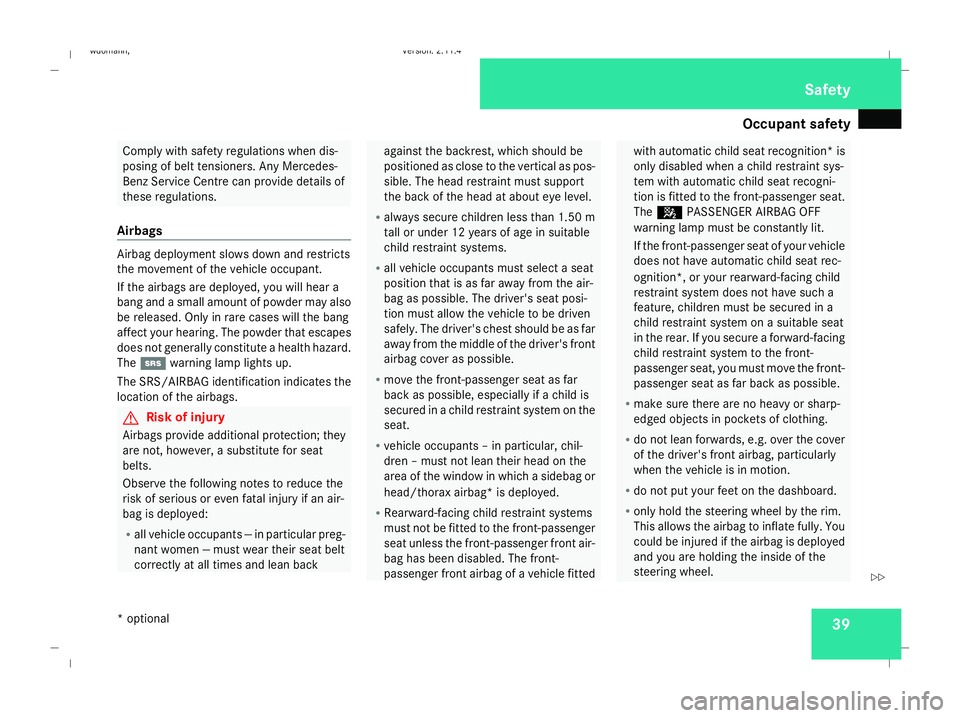
Occupant safety
39Comply with safety regulations when dis-
posing of belt tensioners. Any Mercedes-
Benz Service Centre can provide details of
these regulations.
Airbags Airbag deployment slows down and restricts
the movement of the vehicle occupant.
If the airbags are deployed, you will hear a
bang and a small amount of powder may also
be released. Only in rare cases will the bang
affect your hearing. The powder that escapes
does not generally constitute a health hazard.
The
1 warning lamp lights up.
The SRS/AIRBAG identification indicates the
location of the airbags. G
Risk of injury
Airbags provide additional protection; they
are not, however, a substitute for seat
belts.
Observe the following notes to reduce the
risk of serious or even fatal injury if an air-
bag is deployed:
R all vehicle occupants — in particular preg-
nant women — must wear their seat belt
correctly at all times and lean back against the backrest, which should be
positioned as close to the vertical as pos-
sible. The head restraint must support
the back of the head at about eye level.
R always secure children less than 1.50 m
tall or under 12 years of age in suitable
child restraint systems.
R all vehicle occupants must select a seat
position that is as far away from the air-
bag as possible. The driver's seat posi-
tion must allow the vehicle to be driven
safely. The driver's chest should be as far
away from the middle of the driver's front
airbag cover as possible.
R move the front-passenger seat as far
back as possible, especially if a child is
secured in a child restraint system on the
seat.
R vehicle occupants – in particular, chil-
dren – must not lean their head on the
area of the window in which a sidebag or
head/thorax airbag* is deployed.
R Rearward-facing child restraint systems
must not be fitted to the front-passenger
seat unless the front-passenger front air-
bag has been disabled. The front-
passenger front airbag of a vehicle fitted with automatic child seat recognition* is
only disabled when a child restraint sys-
tem with automatic child seat recogni-
tion is fitted to the front-passenger seat.
The 5 PASSENGER AIRBAG OFF
warning lamp must be constantly lit.
If the front-passenger seat of your vehicle
does not have automatic child seat rec-
ognition*, or your rearward-facing child
restraint system does not have such a
feature, children must be secured in a
child restraint system on a suitable seat
in the rear. If you secure a forward-facing
child restraint system to the front-
passenger seat, you must move the front-
passenger seat as far back as possible.
R make sure there are no heavy or sharp-
edged objects in pockets of clothing.
R do not lean forwards, e.g. over the cover
of the driver's front airbag, particularly
when the vehicle is in motion.
R do not put your feet on the dashboard.
R only hold the steering wheel by the rim.
This allows the airbag to inflate fully. You
could be injured if the airbag is deployed
and you are holding the inside of the
steering wheel. Safety
* optional
245_AKB; 2; 7, en-GB
wdomann
,V ersion: 2.11.4
2008-10-17T11:22:31+02:00 - Seite 39 ZDateiname: 6515_1640_02_buchblock.pdf; preflight
Page 43 of 305
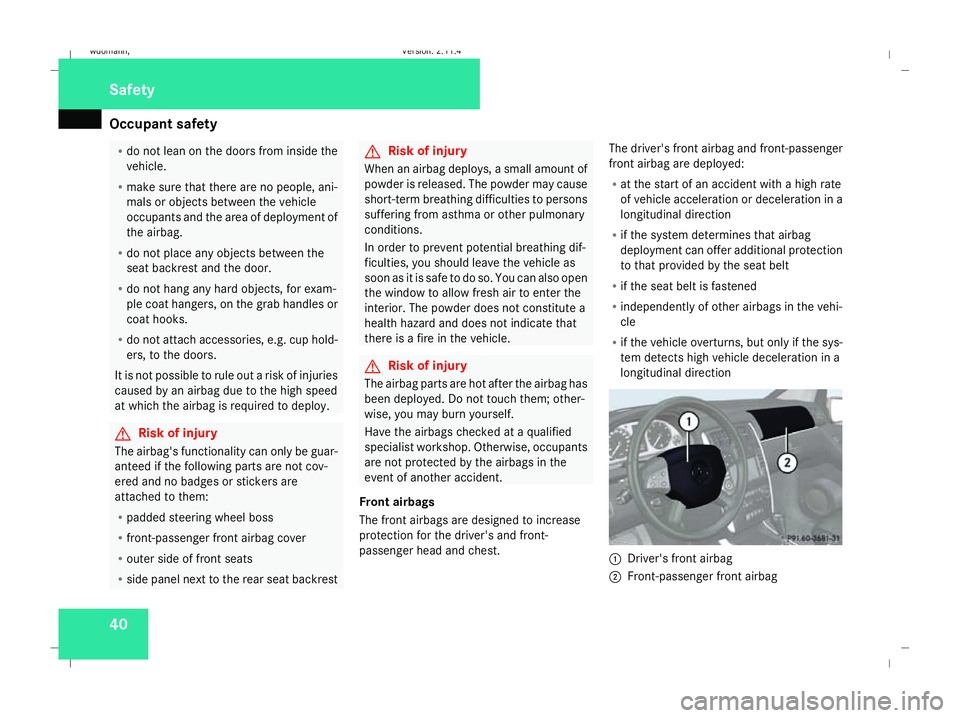
Occupant safety
40 R
do not lean on the doors from inside the
vehicle.
R make sure that there are no people, ani-
mals or objects between the vehicle
occupants and the area of deployment of
the airbag.
R do not place any objects between the
seat backrest and the door.
R do not hang any hard objects, for exam-
ple coat hangers, on the grab handles or
coat hooks.
R do not attach accessories, e.g. cup hold-
ers, to the doors.
It is not possible to rule out a risk of injuries
caused by an airbag due to the high speed
at which the airbag is required to deploy. G
Risk of injury
The airbag's functionality can only be guar-
anteed if the following parts are not cov-
ered and no badges or stickers are
attached to them:
R padded steering wheel boss
R front-passenger front airbag cover
R outer side of front seats
R side panel next to the rear seat backrest G
Risk of injury
When an airbag deploys, a small amount of
powder is released. The powder may cause
short-term breathing difficulties to persons
suffering from asthma or other pulmonary
conditions.
In order to prevent potential breathing dif-
ficulties, you should leave the vehicle as
soon as it is safe to do so. You can also open
the window to allow fresh air to enter the
interior. The powder does not constitute a
health hazard and does not indicate that
there is a fire in the vehicle. G
Risk of injury
The airbag parts are hot after the airbag has
been deployed. Do not touch them; other-
wise, you may burn yourself.
Have the airbags checked at a qualified
specialist workshop. Otherwise, occupants
are not protected by the airbags in the
event of another accident.
Front airbags
The front airbags are designed to increase
protection for the driver's and front-
passenger head and chest. The driver's front airbag and front-passenger
front airbag are deployed:
R
at the start of an accident with a high rate
of vehicle acceleration or deceleration in a
longitudinal direction
R if the system determines that airbag
deployment can offer additional protection
to that provided by the seat belt
R if the seat belt is fastened
R independently of other airbags in the vehi-
cle
R if the vehicle overturns, but only if the sys-
tem detects high vehicle deceleration in a
longitudinal direction 1
Driver's front airbag
2 Front-passenger front airbag Safety
245_AKB; 2; 7, en-GB
wdomann,
Version: 2.11.4 2008-10-17T11:22:31+02:00 - Seite 40Dateiname: 6515_1640_02_buchblock.pdf; preflight
Page 44 of 305

Occupant safety
41
Driver's front airbag
1deploys in front of the
steering wheel; front-passenger front airbag
2 deploys in front of and above the glove
compartment.
On vehicles with automatic child seat recog-
nition in the front-passenger seat*, front-
passenger front airbag 2is only deployed if
the 5 PASSENGER AIRBAG OFF warning
lamp in the centre console is not lit
(Y page 45). This means that there is not a
child restraint system with automatic child
seat recognition* fitted to the front-
passenger seat or that a child restraint sys-
tem with automatic child seat recognition*
has been fitted to the front-passenger seat
incorrectly.
Head/thorax airbags, rear sidebags*
i If you have specified windowbags* as
optional equipment, the front seats of the
vehicle will be equipped with sidebags
instead of head/thorax airbags. G
Risk of injury
If you wish to use seat covers, Mercedes-
Benz recommends that, for safety reasons,
you only use seat covers that have been
approved for Mercedes-Benz vehicles. The seat covers must have a special tear
seam for head/thorax airbags. Otherwise,
a head/thorax airbag cannot deploy cor-
rectly and would fail to provide the intended
protection in the event of an accident.
Appropriate seat covers can be obtained
from a Mercedes-Benz Service Centre.
The purpose of head/thorax airbag deploy-
ment is to enhance the level of protection for
the head and thorax (but not the arms) of the
vehicle occupants on the side of the vehicle
on which the impact occurs.
The purpose of rear sidebag deployment is to
enhance the level of protection for the thorax
(but not the head, neck or arms) of the vehicle
occupants on the side of the vehicle on which
the impact occurs. 1
Front head/thorax airbag
2 Rear sidebag in the side trim next to the
backrest
The front head/thorax airbags or rear side-
bags inflate next to the outer seat cushion.
Front head/thorax airbag 1or rear sidebags
2 are deployed:
R on the side on which an impact occurs
R at the start of an accident with a high rate
of lateral vehicle deceleration or accelera-
tion, e.g. in a side impact
R independently of the seat belt use
R independently of the front airbags
R independently of the belt tensioners Safety
* optional
245_AKB; 2; 7, en-GB
wdomann,
Version: 2.11.4 2008-10-17T11:22:31+02:00 - Seite 41 ZDateiname: 6515_1640_02_buchblock.pdf; preflight